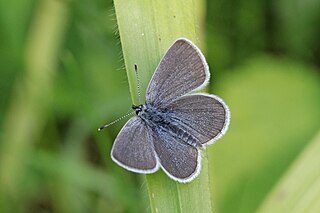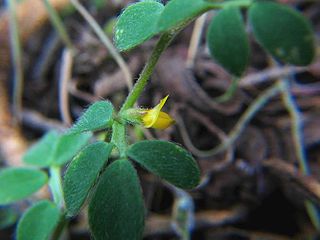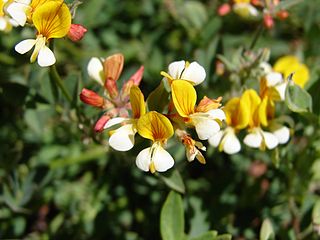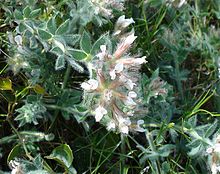
The Faboideae are a subfamily of the flowering plant family Fabaceae or Leguminosae. An acceptable alternative name for the subfamily is Papilionoideae, or Papilionaceae when this group of plants is treated as a family.

The Rhamnaceae are a large family of flowering plants, mostly trees, shrubs, and some vines, commonly called the buckthorn family. Rhamnaceae is included in the order Rosales.

Lotus, a latinization of Greek lōtos, is a genus of flowering plants that includes most bird's-foot trefoils and deervetches and contains many dozens of species distributed in the eastern hemisphere, including Africa, Europe, western, southern, and eastern Asia, and Australia and New Guinea. Depending on the taxonomic authority, roughly between 70 and 150 are accepted. Lotus is a genus of legumes and its members are adapted to a wide range of habitats, from coastal environments to high elevations.

The small blue is a Palearctic butterfly in the family Lycaenidae. Despite its common name, it is not particularly blue. The male has some bluish suffusion at the base of its upper wings but is mostly dark brown like the female. The species can live in colonies of up to several hundred and in its caterpillar stage is cannibalistic.

The genus Securigera contains a number of plant species commonly referred to as crownvetch. It is a segregate of the genus Coronilla. The name Securigera was first published by A. P. de Candolle in 1805 with the single species Securigera coronilla, which is now considered to be a synonym of Securigera securidaca(L.) Degen & Dörfl. (1897), based on the earlier publication of the same taxon as Coronilla securidacaL. in 1753.

Anthyllis is a genus of flowering plants in the family Fabaceae. This genus contains both herbaceous and shrubby species and is distributed in Europe, the Middle East and North Africa. The most widespread and familiar species is A. vulneraria, a familiar grassland flower which has also been introduced to New Zealand.

Anthyllis vulneraria, the common kidneyvetch, kidney vetch or woundwort is a medicinal plant native to Europe. The name vulneraria means "wound healer".

Galegeae is a tribe in the flowering plant family Fabaceae, subfamily Faboideae. The tribe is found mostly in the northern hemisphere, but can also be found in Australia, Africa, and South America. Recent molecular phylogenetic work has determined that tribe Galegeae is paraphyletic, and that its members are scattered throughout the IR-lacking clade.

Tripodion tetraphyllum is a species of flowering plant in the legume family, Fabaceae. It is an annual herb, commonly known as annual kidney vetch, native to the Mediterranean Basin of southern Europe, North Africa, and western Asia. It grows in the Mediterranean–Sahara transition zone of North Africa, and in anthropic landscapes. It is the sole species in genus Tripodion, which belongs to subfamily Faboideae.

Acmispon argophyllus, synonym Lotus argophyllus, is a species of legume native to California and northwest Mexico. It is known by the common name silver bird's-foot trefoil or silver lotus.

Trifurcula cryptella is a moth of the family Nepticulidae. It is widespread throughout Europe, northwards to southern parts of Norway and Sweden, eastwards to Poland and the Balkan Peninsula, and south to the Mediterranean countries, but there it is rare and confined to mountainous regions. In Italy it has only been recorded from the northern part, in Portugal in the Serra da Estrêla, in Spain in the Cantabrian Mountains and possibly the Sierra Nevada. It is absent from the Mediterranean islands.

The tribe Fabeae is one of the subdivisions of the plant family Fabaceae. It is included within the Inverted repeat-lacking clade (IRLC). Five genera are included:

The tribe Robinieae is one of the subdivisions of the plant family Fabaceae and the currently unranked taxon Robinioids.

Acmispon wrangelianus is a species of legume native to California and Oregon in the southwestern United States. It is known by the common names Chilean bird's-foot trefoil and Chile lotus. Despite its common name, it is not from Chile. It can be found in many types of habitat, including disturbed areas. This is a hairy, prostrate annual herb. Its slender branches are lined with leaves each made of generally four small leaflets. The inflorescence is composed of a solitary yellow pealike flower around a centimeter wide. The fruit is a legume pod one to two centimeters long.

The robinioids are one of the four major clades in subfamily Faboideae of the plant family Fabaceae (Leguminosae). It is composed of the traditional tribes Loteae, Sesbanieae and Robinieae. It is a large and important clade that is distributed in mostly temperate areas. Species in this clade share a unique determinate root nodule structure. The clade is predicted to have diverged from the other legume lineages 48.3±1.0 million years ago.

Hosackia is a genus of flowering plants in the family Fabaceae (legumes). It is native to western North America, from British Columbia in Canada to Mexico.

Syrmatium was a formerly accepted genus of flowering plants in the family Fabaceae (legumes), native to the southwestern United States. As of February 2021, it was considered a synonym of Acmispon by Plants of the World Online, and only Acmispon was recognized by the Jepson eFlora.

Lotus glaucus is a species of flowering plant in the family Fabaceae, native to Madeira and the Salvage Islands. It is a perennial herbaceous plant with leaves made up of five leaflets. Its flowers are usually orange on opening. Lotus tenellus is included in a more broadly circumscribed L. glaucus by some authors, which extends its distribution to the Canary Islands.

Lotus tenellus is a species of flowering plant in the family Fabaceae, native to the Canary Islands. Some authors have included L. tenellus in Lotus glaucus, a species found in Madeira and the Salvage Islands. L. leptophyllus may be treated as a synonym of L. tenellus or as a separate species. L. tenellus has yellow flowers, with usually no more than three flowers in each flower head (umbel). Its leaves are made up of five leaflets.

Alice Maria Ottley (1882–1971) was a botanist, author, assistant professor and curator of the herbarium at Wellesley College. She collected and studied American flora, particularly species of Lotus, and publishing books and articles on botany.



















